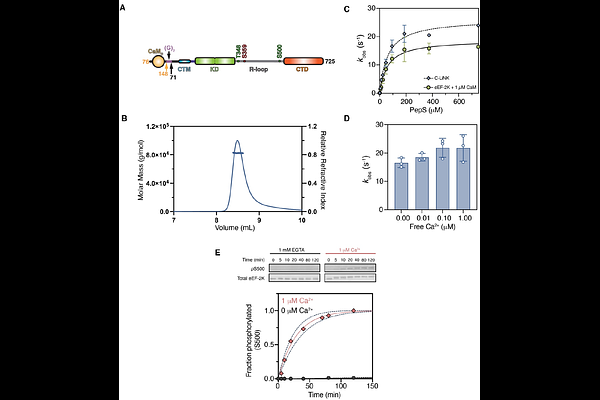The Critical Role of the C-terminal Lobe of Calmodulin in Activating Eukaryotic Elongation Factor 2 Kinase

The Critical Role of the C-terminal Lobe of Calmodulin in Activating Eukaryotic Elongation Factor 2 Kinase
Long, K. J.; Browning, L. S.; Piserchio, A.; Isiorho, E. A.; Gadallah, M.; Douangvilay, J.; Wang, E. Y.; Kalugin, J. K.; Brodbelt, J. S.; Ghose, R.; Dalby, K. N.
AbstractEukaryotic elongation factor-2 kinase (eEF-2K), a member of the -kinase family, modulates translational rates by phosphorylating eEF-2, a GTPase that facilitates the translocation of the nascent chain on the ribosome during the elongation phase of protein synthesis. eEF-2K is regulated by diverse cellular cues, many of which sensitize it to the calcium-effector protein calmodulin (CaM). CaM, which binds and allosterically activates eEF-2K in the presence of calcium, contains two structural lobes, each with a pair of calcium-binding EF-hands. Using kinetic analysis, we demonstrate that the isolated C-terminal lobe of CaM (CaMC) is sufficient to engage and fully activate eEF-2K in a calcium-dependent fashion. Genetically fusing CaMC to the N-terminus of eEF-2K, upstream of its critical CaM-targeting motif (CTM) via a flexible 2-glycine linker, results in a chimeric species (C-LiNK) that is constitutively active independent of external CaM and calcium. A structure of the C-LiNK functional core reveals no significant deviation in the overall conformations of the interacting modules and orientations of key catalytic-site residues relative to the heterodimeric complex between full-length CaM and eEF-2K. These observations demonstrate that, in contrast to other CaM-regulated kinases, CaMC alone is sufficient to activate eEF-2K fully. The proximity effect of CaMC in the context of C-LiNK removes the requirement for external calcium, whose apparent role is to enhance the CaM-affinity of eEF-2K and drive kinase activation. The responsiveness of eEF-2K to regulatory stimuli in cells appears to be lost in C-LiNK, presumably due to its permanently \'on\' state.